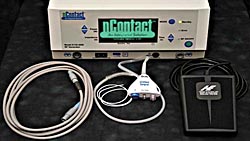Guided coagulation system designed to treat permanent, persistent AF
System enables minimally invasive treatment of heart disorder traditionally difficult to manage.
Treatments for paroxysmal atrial fibrillation are plentiful, but few are designed to treat permanent or persistent atrial fibrillation.
A new device, developed by nContact Surgical Inc., may provide the first stand-alone minimally invasive treatment for permanent or persistent AF that does not require open heart surgery. In addition, the device aims to transform what was once a major invasive open heart surgical procedure into a minimally invasive yet more effective procedure with more pronounced benefits.
Traditional treatments for AF
AF affects about 5 million people in the United States. Traditional treatments for paroxysmal AF range from drug therapy to occasional cardioversion when treating persistent AF.
“AF is, in my mind, an exploding area and has huge potential for medical technology,” Reginald Low, MD, professor and chief of cardiovascular medicine at the University of California-Davis, told Cardiology Today. “It’s an increasing problem with no good solutions. It’s relatively easy to treat if you open the chest up and do open heart surgery and bypasses, but of course, everyone wants to do it without opening up the chest.”
The treatment options offered by the device are an alternative to more invasive traditional procedures, which may require ablation of or around the pulmonary veins. The original maze procedure at times produced the late consequence of pulmonary vein stenosis, so the procedure was altered to include only the isolation of the pulmonary vein in the left atrium. It also requires cardiopulmonary bypass surgery. Surgeons either have to cut the heart into pieces and sew it back together or burn lesion patterns onto the heart surface with a series of catheters inserted into the groin and guided through the veins. These procedures, although generally effective, are difficult to perform and require long hours of surgery.
Potential advantages
|
Source: nContact |
Although the nContact system can be used in both open and closed chest procedures, it was developed primarily with the minimization of invasive AF surgical treatments in mind. Results of early viability studies of the device indicated that minimal damage, if any, is incurred by the system to the surrounding heart tissue. The VisiTrax device, which is the primary component of the nContact system, was granted 501k marketing clearance by the FDA in 2006 and is currently indicated for soft tissue coagulation of cardiac tissue using radio frequency during cardiac surgery.
The system is primarily laparoscopic, using catheters inserted through a series of small incisions and entry ports. A radio frequency-emitting coiled electrode 5 cm in length is the primary acting agent responsible for creating the lesion patterns on the heart. The electrode, secured at the end of a catheter, is held to the surface of the heart by a suction and saline perfusion system controlled by a pump in the external generator unit. The high-intensity radio frequency emitted from the coil cauterizes a 5 cm lesion pattern into the heart tissue after a period of 90 seconds. These lesion lines can be connected and placed virtually anywhere on the heart surface, and the radio frequencies allow the coil to create the lesions deep within the heart tissue.
“The ability of the VisiTrax device to create a visible lesion on the heart is unique. … Since you see [the lesions], you can more easily connect them,” Andy Kiser, MD, cardiothoracic surgeon and director of the Arrhythmia Center of the Carolinas in Pinehurst, N.C., told Cardiology Today. “The device is flexible, so you can make lesions on the irregular surface of the heart. Because I can see the lesions and can put the lesions anywhere I want, it gives the ability to treat both the left and right atria, and that is really the key.”
Simplified procedure
The nContact system also allows surgeons to perform the Ex-Maze surgical procedure on a beating heart. This provides the advantage of allowing the pulmonary veins to be paced in real time to ensure they remain isolated and also allows the physician to monitor the pacing of the heart during and after the procedure to assess its completion and effectiveness.
“The traditional cut-and-sew maze is a stopped heart procedure where we cut the heart into pieces and sew it back together,” Kiser said. “The maze procedure has always been the gold standard with pretty good results, but nobody wants to have their chest split and their heart cut into pieces.”
Because the device uses radio frequency rather than direct heat, there is a minimal risk for damage to surrounding tissue. The recovery time a patient endures is significantly reduced.
“Another advantage of using this device is that since the procedure is done on a beating heart, we have actually seen patients convert during the procedure, which is unheard of,” Kiser said. “The problem I have had is that patients feel so good afterward that they don’t even think they had an operation and want to go home. There are always complications for surgery, but nothing out of the ordinary has really been seen with the VisiTrax device at this point.”
There is some anticipation of the development and eventual proliferation of such technology among AF specialists. The implications for treatment of persistent and permanent AF are of particular interest to the community, according to one surgeon.
“This may open up the area for the patients that have long-standing persistent AF,” Thomas Beaver, MD, thoracic surgeon and assistant professor of medicine at the University of Florida School of Medicine, Gainesville, told Cardiology Today. “The minimally invasive approach has been less successful in that group of patients as opposed to the paroxysmal patients, and that is the key point for this technology. It allows you to do that complete lesion set with transmural lesion lines.” - by Eric Raible
For more information:
- To learn more about nContact’s VisiTrax device, visit www.ncontact.us.


